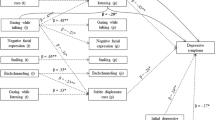Abstract
Two samples of boys were compared on their sensitivity to nonverbal communication: boys not in treatment (sampled from elementary school populations) and boys in treatment (sampled from community mental health clinics). Three main decoding tasks assessed the boys' ability to identify, classify, and predict nonverbal displays. Parent and self appraisals on nonverbal sensitivity were also collected. Results indicated that clinic-recruited boys performed less well than school-recruited boys on the three decoding tasks, but there were no significant differences in the self or parent appraisals. Older boys performed better than younger boys on the decoding tasks, but were not differentiated by self or parent appraisals. Further analyses revealed a significant positive correlation between the level of the boys' social incompetence and poor self-control and the number of decoding errors the boys made on the dominant/submissive but not the negative/positive dimension of nonverbal displays. In addition, the interrelationship of the nonverbal skills appeared to differ across clinic- and school-recruited boys. Results are discussed in terms of their relevance for understanding child psychopathology and their implications for child assessment and treatment.
Similar content being viewed by others
References
Archer, D., & Akert, R. M. (1977). Words and everything else: Verbal and nonverbal cues in social interpretation.Journal of Personality and Social Psychology, 35 443–449.
Argyle, M., Salter, V., Nicholson, H., Williams, M., & Burgess, P. (1970). The communication of inferior and superior attitudes by verbal and nonverbal signals.British Journal of Social and Clinical Psychology, 9 222–231.
Baker, L., & Cantwell, D. P. (1987). Comparison of well, emotionally disordered and behaviorally disordered children with linguistic problems.Journal of the American Academy of Child Psychiatry, 26 193–196.
Beck, L., & Feldman, R. (1989). Enhancing children's decoding of facial expression.Journal of Nonverbal Behavior, 13 269–278.
Borke, H. (1971). Interpersonal perception of young children: Egocentrism or empathy?Developmental Psychology, 5 263–269.
Christensen, D., Farner, A., & Boudreau L. (1980). Sensitivity to nonverbal cues as a function of social competence.Journal of Nonverbal Behavior, 4 146–156.
Cohen, J. C., Davine, M., & Meloche-Kelley, M. (1989). Prevalence of unsuspected language disorders in a child psychiatric population.American Academy of Child and Adolescent Psychiatry, 28 107–111.
Costanzo, M., & Archer, D. (1989). Interpreting the expressive behavior of others: The interpersonal perception task.Journal of Nonverbal Behavior, 13 225–245.
Cowen, E. L., Pederson, A., Babijian, H., Izzo, L. D., & Trost, M. A. (1973). Long-term follow up of early detected vulnerable children.Journal of Consulting and Clinical Psychology, 41 438–446.
Dodge, K. A., & Newman, J. P. (1981). Biased decision-making process in aggressive boys.Journal of Abnormal Psychology, 60 375–379.
Dodge, K. A. (1980). Social cognition and children's aggressive behavior.Child Development, 51 162–170.
Feldman, R. S., White, J. B., & Labato, D. (1982). Social skills and nonverbal behavior. In R. S. Feldman (Ed.),Development of nonverbal behavior in children (pp. 259–277). New York: Springer-Verlag.
Hughes, R., Jr., Tingle, B. A., & Swain, D. B. (1981). Development of empathic understanding in children.Child Development, 52 122–128.
Jöreskog, K. G., & Sörbom, D. (1989).Lisrel 7.2 [Computer program]. Chicago: Scientific Software, Inc.
Lachar, D. (1981).Personality Inventory for Children: Revised format. Los Angeles: Western Psychological Services.
Lachar, D., Gdowski, C. L., & Snyder, D. K. (1982). Broad-band dimensions of psychopathology: Factor scales for the Personality Inventory for Children.Journal of Consulting and Clinical Psychology, 50 634–642.
McCarthy, D. (1972).McCarthy Scales of Children's Abilities. Cleveland, OH: Psychological Corporation.
McNeill, D. (1985). So you think gestures are nonverbal?Psychological Review, 92 350–371.
Mehrabian, A. (1972).Nonverbal communication. Chicago: Aldine-Atherton.
Mehrabian, A., & Wiener, M. (1967). Decoding of inconsistent communications.Journal of Personality and Social Psychology, 6 109–114.
O'Sullivan, M., & Guilford, J. P. (1975). Six factors of behavioral cognition: Understanding other people.Journal of Educational Measurement, 12(4), 255–271.
O'Sullivan, M., & Guilford, J. P. (1976).Four factor tests of social intelligence (behavioral cognition): Manual of instructions and interpretations. Orange, CA: Sheridan Psychological Services.
Philippot, P., & Feldman, R. S. (1990). Age and social competence in preschooler's decoding of facial expression.British Journal of Social Psychology, 29 43–54.
Rosenthal, R., Hall, J. A., DiMatteo, M. R., Rogers, P. L., & Archer, D. (1979).Sensitivity to nonverbal communication: The PONS test. Baltimore: Johns Hopkins University Press.
Rothenberg, B. (1970). Children's social sensitivity and the relationship to interpersonal competence, intrapersonal comfort, and intellectual level.Developmental Psychology, 2 335–350.
Russell, R. L., Greenwald, S., Koch, H., & Rock, D. (1992).Social and linguistic competence of type-II learning disabled versus non-learning disabled boys at two age levels. Manuscript submitted for publication.
Russell, R. L., Greenwald, S., & Shirk, S. (1991). Language change in child psychotherapy: a Meta-analytic review.Journal of Consulting and Clinical Psychology, 59 916–919.
Russell, R. L., Stokes, J. M., Snyder, D. K. (1987). Predicting sensitivity to nonverbal communication from the Personality Inventory for Children.Journal of Consulting and Clinical Psychology, 55 439–440.
Walker, E. (1981). Emotion recognition in disturbed and normal children: A research note.Journal of Child Psychology and Psychiatry, 22 263–268.
Wechsler, D. (1974).Manual for the WISC-R. New York: Psychological Corporation.
Wiener, M., Budney, S., Wood, L., & Russell, R. L. (1989). Nonverbal events in psychotherapy.Clinical Psychology Review, 9 487–504.
Zabel, R. H. (1979). Recognition of emotions in facial expressions by emotionally disturbed and nondisturbed children.Psychology in the Schools, 16 119–126.
Author information
Authors and Affiliations
Rights and permissions
About this article
Cite this article
Russell, R.L., Stokes, J., Jones, M.E. et al. The role of nonverbal sensitivity in childhood psychopathology. J Nonverbal Behav 17, 69–83 (1993). https://doi.org/10.1007/BF00987009
Issue Date:
DOI: https://doi.org/10.1007/BF00987009




